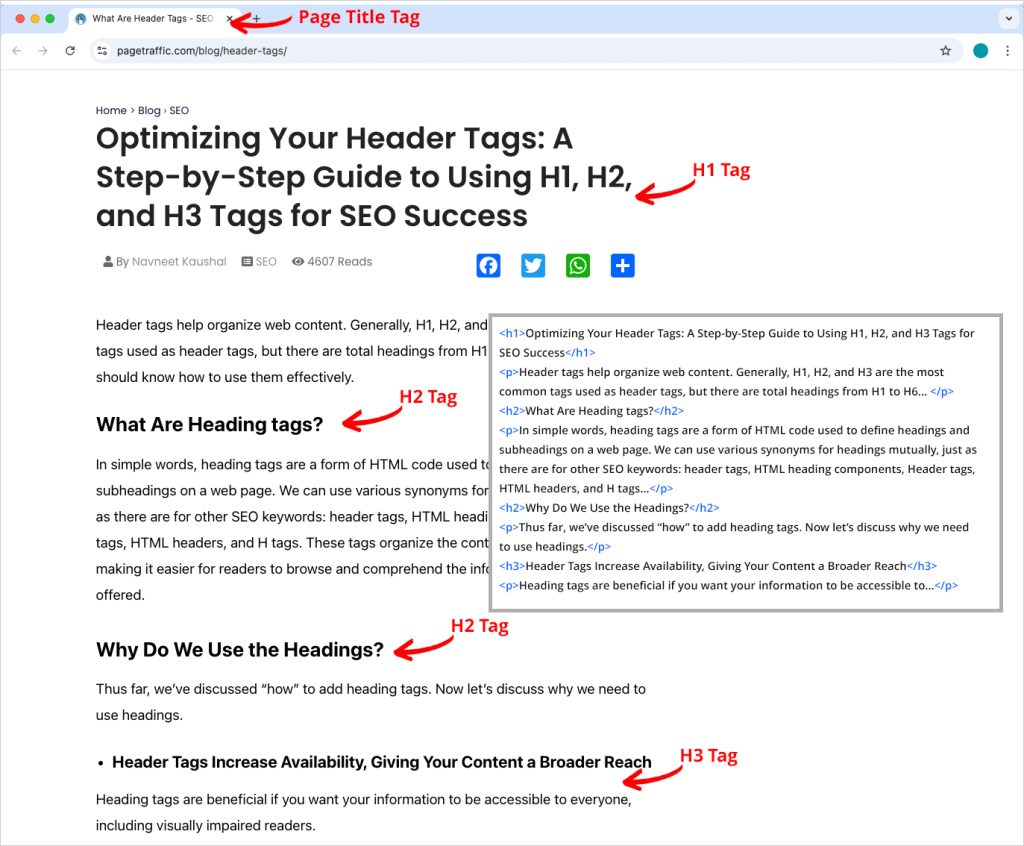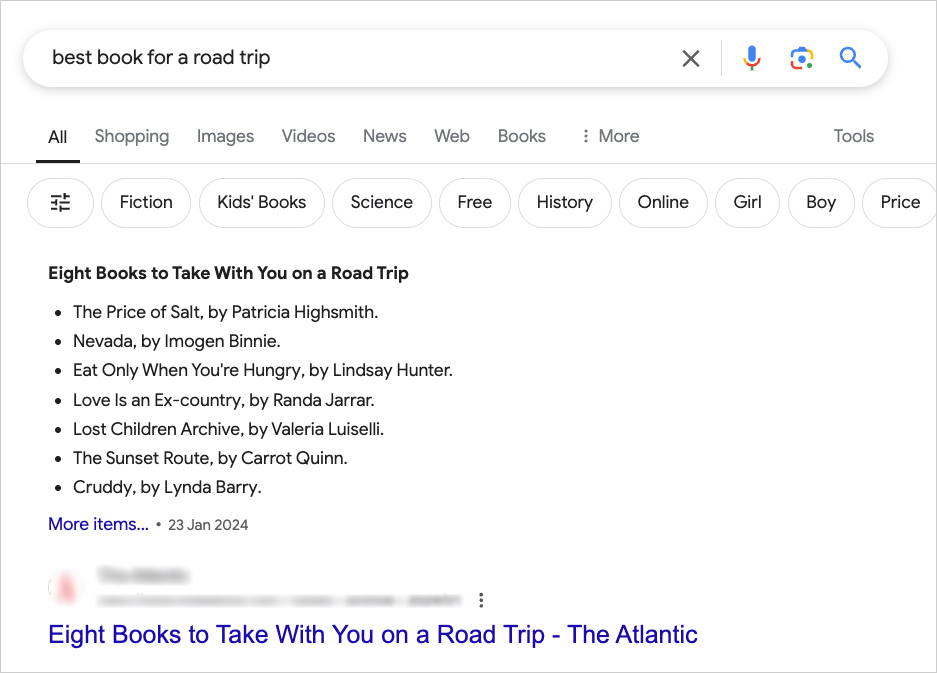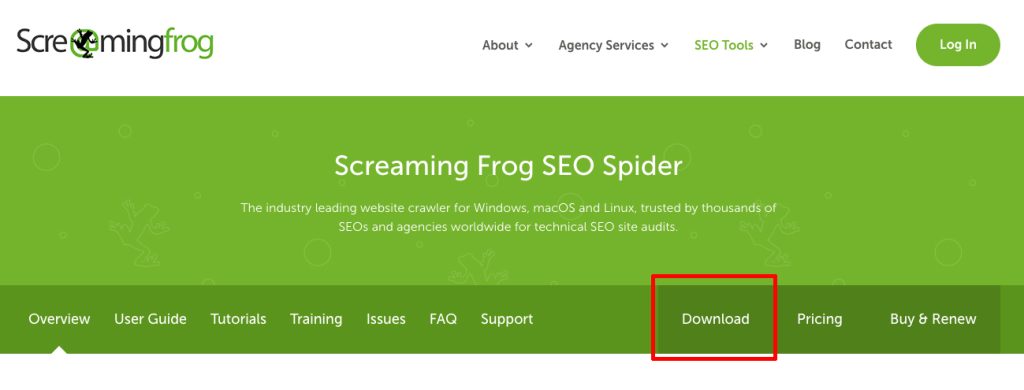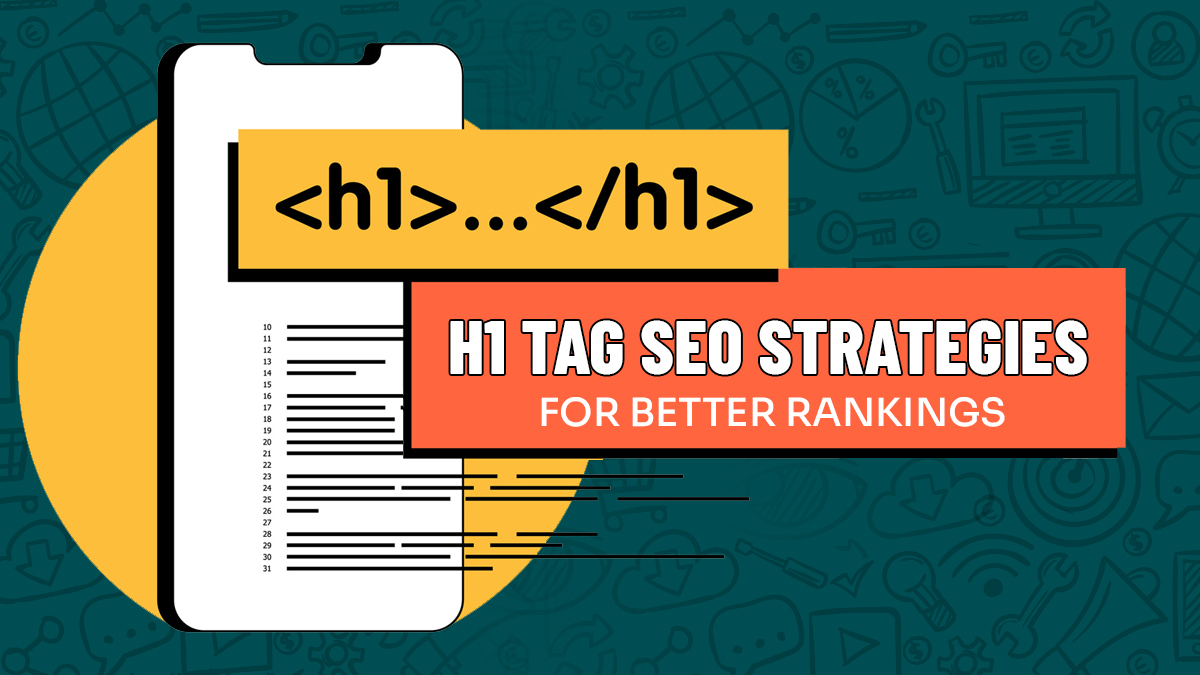Optimizing H1 tags is an important part of on-page SEO that can greatly affect how well your website ranks in search engines. H1 tags, or header tags, are used to show the main title of a webpage.
They are important because they help bots and people to know what the page is about. Well-organized H1 tags help search engines recognize how your content is relevant. This makes it simpler for them to list and rate your pages.
Make sure that every page has a different and clear H1 tag that shows the main keyword and topic. Make it relevant to the content, and don’t overuse keywords. By following the best practices given in this post, you can perform H1 tag SEO.
What is an H1 Tag?
An H1 tag is one of six types of header tags that help organize the content on a webpage. The main pages on your website should use H1 tags to help with SEO. H1 tags help guide readers and show what the page is about.
HTML means Hypertext Markup Language. It is the code that tells web browsers how to show the content of a website. The “H” means “header,” and the number (1 to 6) shows how important each header is on the page.
The H1 tag is usually the first header on a page and is often used to show the title of an article or blog post. For example, if you’re making a blog post using an outline like this:
- How to Make Your Headers Better for Search Engines?
- What is an H1 tag?
- H1 Tags vs Title Tags for Pages
- Importance of H1 Tag SEO
- Making User Experience Better
You can use header styles to show the organization of the article clearly for readers. Your content management system creates HTML code, which Google reads to understand what your page is about.

H1 Tags vs Page Title Tags
H1 tags are often mixed up with page titles because the H1 tag is usually the title of a post. An HTML title tag works differently from an H1 tag. Because of this, they should each be handled in their own way and improved for what they are meant to do.
The H1 tag tells what the content is about. It helps bots understand what the page is about, and when it’s clearly shown at the top of the page, it quickly lets visitors know they are in the right spot.

The title tag also helps bots understand what the page is about, but you can’t see it on the page itself. Instead, the title of the page usually shows up as a link you can click on in search results. But, there is no promise that Google will take your title tag to show in snippets.

Google can choose how title tags look in their search results to make sure users have the best experience. It automatically creates page titles and descriptions, called “snippets,” by looking at the content of a page and other mentions of it online.
Use Google’s guidelines for writing clear and descriptive title tags. This will help make your page’s title link better and keep the number of clicks from search results high. It may show your H1 tag as a title link in search results, so it’s important to make it good.
Importance of H1 tag for SEO
Helps Search Engines
To quickly find good results for searches, Google looks at the headings and titles of a post. Search engine crawlers look closely at the content in header tags to understand what a page is about.
If you want people to find your content easily, use keywords in your headings, especially in your H1 tags. The words in your header tags show how relevant your page is to the questions people are searching for.
This helps you gain traction in your online marketing. A 2021 study by Semrush shows that an H1 tag is very important for how well a website ranks in search results.
Better User Experience
Because Google wants to improve user experience, it’s important to have a clear layout for your page, including an H1 heading. This helps the right people find your article, easily find what they need in it, and stick around to learn more.
An H1 tag helps users by quickly showing them what your page is about. A quick look at the headings in your article can show how helpful your content is and help users feel confident that they will find the information they need.
Using header tags helps make your page easier to understand for search engines. They also divide your content into sections, which helps readers quickly find the information they need while skimming through your post. You always try to help people find the answers they need.
This means they are more likely to stay to learn more about you or from you. When your website has a clear layout, people are more likely to come back. This can help you get an audience who are loyal that you can turn into customers.
Get Featured Snippets
This is a small part of a web page that shows up at the top of the results page to quickly answer a question. Google automatically selects snippet content from pages that are already on the first page of search results.

Making your page ready for a featured snippet before you publish it will make it more likely to get one when it reaches the top ten. To increase your chances of getting a featured snippet, make sure your H1 uses important keywords.
Makes Keywords More Relevant
Using main keywords in your H1 tag makes your page more relevant to those keywords, which is important for SEO. When search engines look at your website, they pay close attention to the H1 tag to see what important words your page is focusing on.
By using important keywords in the H1 tag, you can help the page rank better for those words in search results. It’s important to use keywords naturally and not overuse them, as doing so can harm your SEO.
A good H1 tag with important keywords helps search engines connect your content to what users are searching for. This makes it more likely that your page will show up in relevant search results. This focused strategy can bring more interested visitors to your website, resulting in increased interaction and sales.
Helps with On-Page SEO Hierarchy
H1 tags are very important for organizing the layout of on-page SEO. They act as the main title, under which other smaller titles are arranged, making it simple and clear for both people and search engines to understand.
This structure helps search engines see how different parts of your content are related, making the page easier to understand and more relevant. By using the H1 tag to define the structure, you make a page that is organized and easier for search engines to crawl.
This organized method also makes it easier for people to read and enjoy. Using H1 tags correctly helps keep your website organized, which can improve your search rankings and make the site easier for visitors to use.
Also Read: Winning at SEO: The Voice Search Optimization Edge
10 Best Practices for Creating H1 Tags That are SEO-Friendly
Use One H1 Tag on Each Page
If you’ve looked up information about H1 tags, you might have heard many SEO experts say that you should only use one H1 tag on your web pages. Since your H1 tells what your page is about, it’s best to use just one H1 tag so people understand your page clearly.
That said, it’s common for some HTML 5 website templates or WordPress themes to style headings in key parts of a page, like menus or sign-up boxes, using H1 tags. Crawl bots can move through different sections easily and don’t affect SEO at all.
Having more than one H1 tag on a page isn’t the best practice, but if you can’t easily change it, it won’t seriously hurt your SEO. From a user’s point of view, the most important thing is that there is a clear title at the top of the page that explains what the content below is about.
Write Unique H1 Tags
Your H1 tags show both users and Google what your page is about, so every page on your website should have its own unique H1 tag. Using the same H1 tags on different pages can make visitors and search engines think those pages have the same content.
Having duplicate content won’t get you in trouble, but if you have several pages that look very much alike, it could affect how much traffic your site gets from searches.
When the same H1 title is used on different pages, search engines can’t tell which one is better for a specific search. As a result, Google may choose to show a competitor’s page that is more relevant to the search.
Create Clear H1 Tags
Your H1 should clearly tell your readers what they will be reading about and should match the topic in the title tag. Your H1 should meet what your title tag promises in search results. Your content should live up to what your headline says.
Making clear H1 tags is important for good SEO and a great user experience. An H1 tag should clearly show the main topic of your webpage so that both search engines and people can understand it right away.
Use clear and brief words that include important keywords, but don’t add too much information. Each H1 tag should be one-of-a-kind for its page and not repeated on other pages.
Also, add the H1 tag clearly at the top of the page to help users understand the content better. A good H1 tag helps your webpage show up better in search engines and makes it easier for people to read. This way, users can find what they’re looking for quickly.
Don’t Have the Same H1 and Title Tag
There is no effect on your ranking if your H1 tag and title tag are the same, but it’s better not to use the same text for both. Because your H1 tags and page titles both help with SEO, but they do different things for people searching and visiting your site.
When you treat them all the same, you’re missing a chance to make the best use of each one for what it’s really meant for.
- The Use of Title Tags
These are the names of your pages that show up in search results. They help grab people’s attention and make them want to click on your content instead of others.
The main job of a title tag is to persuade people who haven’t clicked on it yet that your content has the best answer to what they’re looking for. The title of your page tells people what they can expect to find when they click on a search result.
- The Use of H1 Tags
Your H1 should clearly show what the page is about. Its main job is to meet the needs shown in search results and make sure visitors know they found a page with the information they want. Also, an H1 tag introduces the content that comes after it, just like a topic sentence in an essay.
Don’t Overload H1 Tags With Keywords
Don’t stuff your H1 with too many keywords to boost your ranking. Google sees over-optimization as trying to trick the system, which makes it think your page may not be reliable.
When people visit your page and see a headline filled with too many keywords, they will probably react in a similar way. The following is a bad example of an H1 tag that might make readers leave to find better content:
‘What is an H1 tag in SEO? Importance of H1 tags in SEO and How to Write H1 Tags for Better SEO’. In general, it’s better to focus on how users feel when using your website instead of worrying too much about using certain words often.
Add Your Main Keyword in H1 Tag
A popular SEO rule is to make sure your H1 includes the main keyword you want to rank for. You want your H1 to clearly connect your content to the search terms that bring visitors to your site.
The best way to do this is to use the keyword you want to rank for and think about what users are looking for. Adding your main keyword in the H1 tag is an important SEO tactic that helps search engines know what your page is about.
Using the main keyword shows search engines that your content matches certain searches, which can help it show up higher in search results. Make sure to include the keyword in the H1 tag in a way that is easy to read.
This method helps improve your ranking and makes it easy for users to understand what your page is about, making their experience better. A good H1 tag with the main keyword can bring more people and keep them interested by matching what they’re looking for.
Also Read: Keyword Mapping Explained: 10-Step Guide + Useful Tips
Write H1 Tags According to Search Intent
Search intent is the reason someone is using a particular search term. In simple terms, the reason for a search is important. It’s just as crucial to understand what someone really wants to find as it is to match the specific words they use in their search.
A good way to understand what users want is to use a specific keyword phrase for your heading that matches the purpose of your content. Using a specific keyword that matches what people are looking for will bring more relevant visitors to your website.
The H1 tag is the main tag on a page, and it serves as the title of that page. If your content is about planning a Europe trip, the H1 tag should grab the attention of people looking for helpful information, like below:
How to Plan a Europe Trip Within Your Budget?
But if your goal is to get people interested in buying accessories for their gaming laptop, you should create a heading like this:
5 Must Have Accessories for Your Gaming Laptop
Ideal Length for H1 Tags
There’s no strict limit on how long your H1 can be, but it’s a good idea to keep it between 20 and 70 characters, including spaces and punctuation. We try to target around 55 characters.

A title shorter than 20 characters is likely too vague to give real information. If your H1 is more than 55 characters long, it might get cut off in search results if Google doesn’t use the page title for your listing.
Have a Unique Style for Your H1 Tag
Your website design should make your H1 stand out as the most important part of the text on your page. It should be pleasant, easily readable, and strong. Remember that your H1 shows users they are in the right spot. Don’t make them guess about that. Make it clear.
Having a special look for your H1 tag can help your webpage look different and grab people’s attention. A clear H1 tag should match the style of your website and show what the main topic is.
Being creative with your H1 tag can grab users’ attention and leave a strong impression. Don’t use fancy or complicated words. Instead, choose a way of speaking that connects with the people you’re trying to reach.
A good H1 tag improves how users feel about your site and makes your content stand out from others. By making the H1 tag match your brand’s style and keeping it interesting and helpful, you can boost your rankings and keep users more engaged.
Use Other HTML Header Tags
Your header tags should help organize the information on your page. For example, if you think of your H1 as the title of a book, then your H2s should act like chapter titles, showing the main topics you will talk about.
Other headings (H3s to H6s) act as smaller titles within each section, similar to how a book chapter is divided into different subtopics. Using HTML heading tags carefully helps visitors quickly browse your page and shows search engines how your text is organized.
How to Audit Your H1 Tags?
Now that you’ve learned about SEO tips for headers, we want to show you a simple way to use this knowledge so you can improve your website traffic. Let’s audit your current H1 tags to see which ones need to be better.
Step 1: Download SEO Spider tool from Screaming Frog. 500 URLs can be crawled for free.

Step 2: Inside the tool, type in your website address, and press Start.

Step 3: Click on H1 in the menu at the top.

Step 4: Look at Your Results.

The list will show information for each page on your website and the H1 for each page. You will see a summary of mistakes on the right side of the list. You can click on each mistake to see only the pages with H1s that need work.
Final Thoughts
Optimizing H1 tags helps both search engines find your page and makes it easier for users to read. By making special and clear H1 tags for each webpage, you help search engines understand and organize your content better.
A good H1 tag shows what your main topic is and helps users navigate your page, making it easier and more interesting to read. Don’t overuse keywords and make sure the H1 tag is short but clear. This helps improve search engine ranking and makes the content easier to read.
Frequently updating your H1 tags as part of your SEO plan can help keep your website’s performance improving over time. Following these simple rules for H1 tags will help you get more visitors from search engines, make users happier, and lead to lasting success online.
FAQs
How does the H1 tag impact rankings in search results?
The H1 tag helps search engines understand what the page is mainly about, which can improve its ranking. Search engines use this tag to see how related the content is to what people are searching for. Using an H1 tag correctly can help a page show up in search results that match what people are looking for. This can help your website go higher in results pages and make it easier for people to find your content.
Can having more than one H1 tag on a page affect SEO?
Using more than one H1 tag on a single page can hurt your SEO. It can make it hard for bots to know what the page is really about, which might weaken the main idea of the content. It’s usually a good idea to use just one H1 tag on each page to show the main heading clearly. Use headings like H2 and H3 to organize the rest of the information.
Does H1 tag length matter for SEO?
Yes, the length of the H1 tag is important for SEO because it needs to be short but also explain the topic well. A clear and simple H1 tag helps both search engines and users quickly see what the content is about. Don’t use H1 tags that are too long or complicated, as they may not work well. Making things simple and related helps both search engines and users.
When should I update my H1 tags?
Checking and updating your H1 tags often helps keep them relevant and useful. Update them whenever you make new content or important updates to current pages. Using the right H1 tags that match your content helps improve your SEO. You can also change them when you feel the change would be better for SEO. This ongoing improvement can result in higher search rankings and more user interaction.
Do H1 tags affect the click-through rates in search results?
Yes, good H1 tags can help get more clicks from search results by grabbing people’s attention. People tend to click on the site that grabs their attention immediately. A good H1 tag that fits what people are looking for can get more clicks to your webpage. Higher click-through rates show search engines that your content is important and useful. This can help you get good rankings and more users to your business.
























